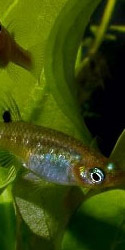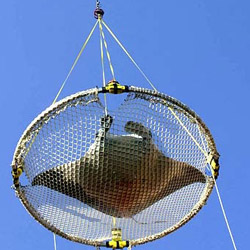|
Home » Articles » Reproductive Behavior in Freshwater Fish

 Fish can be divided into two broad categories on the basis of their breeding behavior. Egg-layers, which form the majority, practice external fertilization, while in live bearers the eggs are fertilized in the female’s body and emerge fully formed young. Some species show little regard for their offspring and cannibalize their own eggs or fry. Others display surprisingly high levels of parental care. Fish can be divided into two broad categories on the basis of their breeding behavior. Egg-layers, which form the majority, practice external fertilization, while in live bearers the eggs are fertilized in the female’s body and emerge fully formed young. Some species show little regard for their offspring and cannibalize their own eggs or fry. Others display surprisingly high levels of parental care.
When fish mate, it is known as spawning. In egg-layers, this involves the male releasing sperm into the water at roughly the same time that the female expels her eggs nearby, so that fertilization occurs outside the females body. This is a rather haphazard method of reproduction, and not surprisingly, a significant proportion of the eggs fail to become fertilized. In order to maximize the chances of fertilization occurring, some egg-layers attempt to maneuver their genital openings as close to each other as possible before spawning occurs, and there is occasionally contact between the fish, such as embraces with the fins.
Reproduction in live bearers:
The likelihood of fertilization in greatly enhanced in live bearing species, which practice internal fertilization. The male live bearer introduces his sperm directly into the female’s body using his anal fin, which is typically modified into a tubelike projection called a gonopodium. The eggs are fertilized inside the female, and then developed in the relative safety of her body. The male’s gonopodim carries sensory organs that help him to guide it to the female’s genital pore. The shape of the gonopodium varies between different live bearing species, and its appearance is used by zoologist as a means of distinguishing between them. Males with a long gonopodium are able to mate easily. Spawning is more intimate for males with a short gonopodium, and courtship plaus a greater role in such species, helping the female to feel comfortable with the male being so close.
During mating, sperm are transferred into the female’s body in the form of a sperm packet. This dissolves within about 15 minutes, freeing the sperm. Any sperm that fail to fertilize immediately do not die off, as happens in the mammalian reproductive tract, but instead remain viable for the life of the female, probably nourished by and output of sugars from the ovaries. This is why a female live bearer housed on her own can still give birth to successive broods of fry, using stored sperm from the past matings to fertilize the eggs. As a result, a number of males may be responsible for the young born in a single-brood.
In some live bearers, including Guppies, the embryos are nourished by their yolk sac as the eggs develop in their mothers body. As she gives birth, the fry hatch from there eggs. In the One-Sided Live bearer(Jenynsia lineata), placenta-like links form between the body of the female and the embryos. The mother provides nutrients through cords or mouth and gills of the young fish.
Breeding strategies in egg-layers:
Since live bearers nurture their young through the most vulnerable early stages of life, they do not need to reproduce as many offspring as egg-layers. An egg-laying female may lay hundreds or thousands of eggs, of which only a small proportion survive and hatch. Although the incubation period is brief- often about 36 hours- the eggs are at grat risk during this time. Eggs are eagerly devoured by fish(sometimes even the parents) and other aquatic animals, since they provide a rich source of protein. Some egg-layers deposit their eggs ub relatively inaccessible places where they are most likely to escape the attention of predators, such as in caves, on the underside of leaves, or even, in the case of Lamprologus cichlids, in empty snail shells. Others guard their eggs until they hatch.
To protect their eggs from the dangers of incubating in the open, a number of species exhibit a behavior called mouth-brooding. After spawning, one or the other of the pair carries the eggs in the mouth for up to three weeks until they hatch, during which time the adult fish does not feed. The fry emerge from their parent’s mouth when they are able to swim freely. Mouth brooding is best-documented in members of the cichlid family, but it also occurs in some bettas and catfish. These fish produce far fewer egs than other egg-layers, but their eggs stand a better chance of survival.
Survival of the fry:
 Fry that hatch in the open initially lie largely immobile, close to where they hatched, until they have digested the remains of their yolk sac- a process that may last several days. Many species that guard their eggs also show parental care toward their fry. Some cichlids, for example, herd their offspring into spawning pits that they excavate in the substrate, where they can watch over their brood. Several such spawning pits may be dug and used during the early days after the young have hatched. The combined tail movements of the fry set up tiny currents above the pit, increasing the flow of oxygen-rich water over the developing young. Even when the fry are free-swimming, the adults will chase after and catch individuals that separate from the school, and carry them back to the group in their mouths. They warn the young of possible danger by distinctive movements of their brightly colored pelvic fins. This behavior, known as jolting, sends out both visual signal and a pressure wave that alert the fry to an approaching threat. Some cichlids, including Discus, even produce food for their young in the form of secretions that the fry nibble from the flanks of the adults. Fry that hatch in the open initially lie largely immobile, close to where they hatched, until they have digested the remains of their yolk sac- a process that may last several days. Many species that guard their eggs also show parental care toward their fry. Some cichlids, for example, herd their offspring into spawning pits that they excavate in the substrate, where they can watch over their brood. Several such spawning pits may be dug and used during the early days after the young have hatched. The combined tail movements of the fry set up tiny currents above the pit, increasing the flow of oxygen-rich water over the developing young. Even when the fry are free-swimming, the adults will chase after and catch individuals that separate from the school, and carry them back to the group in their mouths. They warn the young of possible danger by distinctive movements of their brightly colored pelvic fins. This behavior, known as jolting, sends out both visual signal and a pressure wave that alert the fry to an approaching threat. Some cichlids, including Discus, even produce food for their young in the form of secretions that the fry nibble from the flanks of the adults.
Nor is it just cichlids that display parental care. A number of catfish also guard their eggs, as do various anabatoids, including the popular Siamese Fighting Fish. The male of this species constructs a special nest for the eggs by blowing air bubbles, and then guards the nest and watches over its fry during the immediate post-hatching period, when they are at their most vulnerable.
The more developed fry are when they emerge into their surroundings, the better their chances of survival. Mouth-brooding helps to give the fry of some egg-layers a head start in life. The female Mosquito fish, a livebearer, uses a different process, called superfetation, to improve the odds for her young at varying stages of growth. As a result, Least Killiefish fry are proportionately larger and better developed than those of similar live bearers when they are born.
Further discussion of this article can be found by clicking here
This is an article post submitted by: Silver Dollars
|


 Fish can be divided into two broad categories on the basis of their breeding behavior. Egg-layers, which form the majority, practice external fertilization, while in live bearers the eggs are fertilized in the female’s body and emerge fully formed young. Some species show little regard for their offspring and cannibalize their own eggs or fry. Others display surprisingly high levels of parental care.
Fish can be divided into two broad categories on the basis of their breeding behavior. Egg-layers, which form the majority, practice external fertilization, while in live bearers the eggs are fertilized in the female’s body and emerge fully formed young. Some species show little regard for their offspring and cannibalize their own eggs or fry. Others display surprisingly high levels of parental care. Fry that hatch in the open initially lie largely immobile, close to where they hatched, until they have digested the remains of their yolk sac- a process that may last several days. Many species that guard their eggs also show parental care toward their fry. Some cichlids, for example, herd their offspring into spawning pits that they excavate in the substrate, where they can watch over their brood. Several such spawning pits may be dug and used during the early days after the young have hatched. The combined tail movements of the fry set up tiny currents above the pit, increasing the flow of oxygen-rich water over the developing young. Even when the fry are free-swimming, the adults will chase after and catch individuals that separate from the school, and carry them back to the group in their mouths. They warn the young of possible danger by distinctive movements of their brightly colored pelvic fins. This behavior, known as jolting, sends out both visual signal and a pressure wave that alert the fry to an approaching threat. Some cichlids, including Discus, even produce food for their young in the form of secretions that the fry nibble from the flanks of the adults.
Fry that hatch in the open initially lie largely immobile, close to where they hatched, until they have digested the remains of their yolk sac- a process that may last several days. Many species that guard their eggs also show parental care toward their fry. Some cichlids, for example, herd their offspring into spawning pits that they excavate in the substrate, where they can watch over their brood. Several such spawning pits may be dug and used during the early days after the young have hatched. The combined tail movements of the fry set up tiny currents above the pit, increasing the flow of oxygen-rich water over the developing young. Even when the fry are free-swimming, the adults will chase after and catch individuals that separate from the school, and carry them back to the group in their mouths. They warn the young of possible danger by distinctive movements of their brightly colored pelvic fins. This behavior, known as jolting, sends out both visual signal and a pressure wave that alert the fry to an approaching threat. Some cichlids, including Discus, even produce food for their young in the form of secretions that the fry nibble from the flanks of the adults.



{ 3 comments… read them below or add one }
Nice write up! Thanks for the information. Breeding fish has always been a challenge for me so I appreciate all new information on the subject.
Thanks
Its a pleasure to learn more from your expediture,that is the reward of hard work,pls keep it up.
I have 4 fishes like the ones in the photo and I have to thank you for giving me the chance to know how to let them reproduce, I followed all of your info in this blog and it worked, thank you